|
西方文明史Western Civilization (1) & (2)
|
英文系
蘇文伶與墨樵、
Wen-ling Su & Joseph Murphy
|
製作日期
July 2011
|
|
 網頁教材
網頁教材 |
|
| 歷史斷代 Historical Periods
|
1.希臘時期 The Greeks
2.中世紀時期 The Middle Ages
3.文藝復興 Renaissance
4.北方文藝復興 Northern Renaissance
5.巴洛克時期The Age of Baroque
6.啟蒙時期Enlightenment
7.浪漫時期The Romantics
8.現代主義 Modernism
9.現代主義研究 Modernism Survey
10.後現代主義 From Modernism to
Postmodernism |
|
The Age of Baroque
(ca 1550-1570)
|
|
I. Historical
Context
A. Chronology of
major events
B. Catholic
Reformation
C. Absolutism
i. Louis XIV in
France
ii. The English
Exception
II. The
Baroque Style
A. Roots in
mannerism
B. Baroque Arts
i. Painting
ii. Sculpture
|
The
Catholic Baroque |
Italy |
|
The
Classical Baroque |
France,
Spain and elsewhere |
|
The
Protestant Baroque |
Northern
Europe |
|
|
I. Historical Context: |
|
A.
Chronology |
|
1450-1750
an era of European overseas exploration and expansion
1534
the
Society of Jesus, or the Jesuits, founded by Ignatius Loyola
1545-1563
the
Council of Trent to reform the Catholic church
1562-1598
religious
wars in France
1588
England defeated the Spanish Armada
1609
Holland and Flanders given virtual independence in truce with Spain
1618-1648
the
Thirty Years’ War, which ended with the Peace of Westphalia in 1648.
1642-1649
the English Civil War
1649-1658
Oliver
Cromwell ruled in England
1661
beginning of Louis XIV’s absolutism in France
1682
Louis XIV moved court to Versailles
1688
the
Glorious Revolution in England; Declaration of Rights established
English constitutional government

|
|
B. Catholic Reformation
|
|
Two
Phases: before and after Martin Luther
A.
Before Martin Luther:
A Catholic Reformation beginning around 1490, “an internal program
of papal and monastic reform” inspired by Christian humanists such
as Erasmus and Thomas More. (Fiero 28)
B.
After Martin Luther:
“A
Counter-Reformation that responded to challenges posed by
Protestantism. Under strong papal leadership, the Church launched an
aggressive evangelical campaign to win back its lost congregation”
(Lerner et al. 493).
1. Council of Trent
--tightened discipline
2. the Jesuits
--Ignatius Loyola
--Missionary works abroad
--Francis
Xavier
--Matteo Ricci
|
|
Council of Trent
1545-1563 the
general council met at intervals to... |
|
A.
reform the church:
1.
Unified church doctrine
2.
Abolished
corruption, such as selling indulgences
B.
confront the Protestant challenge:
Reconfirmed:
1.
transubstantiation
2.
the apostolic succession of the priesthood
3.
the belief in purgatory
4. the rule of celibacy for the clergy
(Perry 238; Cunningham & Reich 351)
|

“Council of Trent.” Web.
27 July 2011
http://wikipedia7thgradestyle.pbworks.com/w/page/11474682/Period5 |
|
|
Tightened Discipline |
|
The
sterner means of control adopted by the Catholic Church included:
A.
The Inquisition:
the
church court to try and convict heretics
B.
Censorship:
Index Expurgatorius
(Index of Prohibited Books): a list of books forbidden to
Catholic readers
(Perry
238)
|

“Galileo’s inquisition.” 1633 Spad’s
Literary PotPourri. Web. 27 July 2011.
http://spad1.wordpress.com/2009/12/23/galileos-inquisition/
|
|
|
The Jesuits
|
|
1.
Ignatius Loyola
2. Missionary
work abroad: Francis Xavier,
Matteo Ricci
|
|
1. Ignatius Loyola (1491-
1556) |

A
Spanish nobleman
1521 a Spanish
Basque soldier who had a mystical conversion experience while
recuperating from a leg injury in
battle.
- 1534 founded
the Society of Jesus, or the Jesuits
- 1535
completed The Spiritual Exercises, a meditation guide for all
Jesuits
“We must put
aside all judgment of our own, and keep the mind ever ready and
prompt to obey in all things the true Spouse of Christ our Lord, our
holy Mother, the hierarchical Church.”
“If we wish to
proceed securely in all things, we must hold fast to the following
principle: What seems to me white, I will believe black if the
hierarchical Church so defines. . . . “
(Loyola’s Spiritual Exercises, quoted in Fiero 39)
|

“The Spiritual exercises of St. Ignatus.” Catholic
First. Web. 27 July 2011.
http://www.catholicfirst.com/thefaith/catholicclassics/
ignatiiusloyola/spiritualexercises.html |
|
|
2. Missionary Work Abroad
|
|
(1) Far East:
a. China:
Targeting the intellectual classes, Catholic missionaries succeeded
in winning converts among the scholars.
b. Japan:
By 1606, the Japanese outlawed Christianity for it was perceived to
be potentially subversive. In 1624, all Western foreigners were
expelled.
(2) Americas:
Christian evangelism proved to be more successful in Spanish
Americas (notably in Mexico and Peru) than elsewhere. Catholicism
went hand in hand with colonization, however.
(Fiero
40)
|
|
Francis Xavier (1506-1552) |
|
|
|
Matteo Ricci
(1552-1610) |
|
|
|
C. Absolutism
|
|
Definition:
17th Century absolute monarchs:
-Louis XIV of
France (prime example)
-Peter the Great
of Russia
-Leopold I of
Austria
-Frederick
William of Brandenburg-Prussia
The English Exception
|
|
Absolutism: Definition |
|
Time:
dating from the beginning of Louis XIV’s rule in France (1661) to
the French Revolution (1789).
monarch + nation:
“A political
theory that encouraged rulers to claim complete sovereignty within
their territories.” (Lerner et al. 593)
|
|
Absolutism: Theory |
|
The divine right
of kings: “God is holiness itself, goodness itself, and power
itself. In these things lies the majesty of God. In the image of
these things lies the majesty of the prince. ” (Bishop
Jacques Bossuet, Politics Drawn from the Very Words of Scripture,
1708; qtd. in Lerner et al. 596) |
|
Absolutism: Main Features |
|
Absolute
Monarchy
→
Centralization
Possessing a
large standing army
Creating a
centralized bureaucracy to be in charge of taxation
Keeping the
nobles under control
Adopting expansionist policies—wars, wars, and more wars
|
|
i. The Bourbons in France
|
|
Henry IV
(1589-1610)
--Edict of Nantes (religious tolerance)
Louis XIII
(1610-1643)
--Cardinal Richelieu (1624-42)
--Raison d’état
: the national interest
Louis XIV
(1661-1715)Prime Example

Rigaud, Louis XIV, 1701, Louvre, Paris.
|
--Cardinal Mazarin (1602-61)
--Jean Baptiste Colbert (1619-83)
--Mercantilism: exports spurred, imports reduced
Louis XIV
1643 Five-year-old Louis XIV ascended throne of
France under regency of his mother
1661 Louis XIV assumes full control of France
1682 Louis XIV moved court to Versailles
1715 Louis died after 72-year reign
(Cunningham & Reich 348)
Louis
XIV
Identified with the sun god Apollo and referred to
himself as le roi soleil
(the Sun King)
Represented the height of absolutism: “L’état, c’est
moi” (“I am the state.”)
Maintained an extravagant court at Versailles
A great patron of arts: as propaganda
(Fiero 61) |
|
|
ii. The English
Exception
|
|
History
Review
1--The 17th
century
Turning point:
the glorious revolution
History review 2--1066
the Norman
Conquest; origin of the nation state
The Tudor
Dynasty
Henry VII
(1485-1509)
Henry VIII
(1509-1547)
Elizabeth I
(1558-1603)
The 17th Century:
The Stuart
Dynasty
James I
(1566-1625):
an absolute king
Charles I
(1625-1649):
an absolutist
king, advocating the divine rights of king; had clashes with the
parliament
The Puritan
Revolution (1642-51):
civil war
Oliver
Cromwell
(1599-1685)
|
The 17th Century: the
Restoration
Charles II
(1660-85):
the
Merry Monarch
Tories:
those who supported the king
Whigs:
those who opposed the king
James II
(1685-1688)
Admired French absolutism
Attempted to restore Roman Catholicism
Turning Point
The Glorious
Revolution
(1688-1689) : A
peaceful coup of Mary and William
Bill of Rights
(1689):Parliament became much stronger than before. Britain turned
into a constitutional monarchy.
|
|
|
The Glorious Revolution
|
|
In
the summer of 1688, seven English noblemen wrote to the Dutch
leader, the Protestant William, Prince of Orange, requesting his
assistance to depose James II, who had taken steps to reinstate
Catholicism and given signs of doing without Parliament.
On
5 November 1688 William landed with a massive invasion force and
within six weeks James had fled the country.
Three months
later William and his English wife Mary, James II's Protestant
daughter, were crowned joint monarchs, and accepted the 'Declaration
of Rights', the document that affirmed Parliament's ancient rights
and liberties.

|
|
II. The Baroque Style
|
|
A. Roots in Mannerism |
|
Mannerism
(a)
A
pejorative term in the 17th century, referring to works
associated with
1.
artificiality
2.
self-conscious virtuosity
3.
capricious elegance
(Lucie-Smith
222)
(b)
Now applied to Italian painting and sculpture of the period between
the climax of High Renaissance (1520, the year Raphael died) and the
beginning of Baroque (1590-1610).
|
|
Mannerism: Definition |
|
(a) An
art more focused on style (derived from the Italian word “maniera”)
than content.
(b) Brought a new level of psychological intensity to visual expression
--Mirrored the self-conscious spirituality and deep insecurities
generated by Europe’s religious wars and political
rivalries.
(Fiero 43)

|
|
B. Baroque's Art |
|
i.
Painting |
|
Main Features
-figural
distortions
-irrational
space,
-bizarre
colors,
-general
disregard of Renaissance “rules” (symmetry & geometric clarity)
A
common technique
figura
serpentinata:
the serpentine line
The figure and
all its parts should resemble the letter S. All the figures are
characterized by athletic twists and turns.
Food for Thought
Compare and contrast the three pairs of images below. Specifically
how do the mannerist art works deviate from rules of Renaissance
art? Give concrete examples.
|
|
Renaissance vs.
Mannerism
|
|
(left)
Leonardo da Vinci, “The Last Supper.” 1495-98. Wikipedia.
Web. 27 July 2011.http://ilo.wikipedia.org/wiki/
(middle)
Tintoretto, “The Last Supper.” 1592-1594. Wikipedia.
Web. 27 July 2011.http://en.wikipedia.org/wiki/Last_Supper_(Tintoretto)
(right) Raphael,
“Alba Madonna.” 1510. Smarthistory. Web. 27 July 2011.
http://smarthistory.org/raphael.html |
|
|
|
(left)
Parmigianino,
“The Madonna of the Long Neck.” c. 1535. Wikipedia.
Web. 27 July 2011.
http://en.wikipedia.org/wiki/Madonna_with_the_Long_Neck
(middle)
Leonardo da Vinci, “Annunciation .” 1472-75. Web. 27 Jul7 2011.
http://www.lems.brown.edu/vision/people/leymarie/Refs/VisualArt/Figs/VinciAnnunciation.jpg
(right) El
Greco, “The Annunciation” 1600. Olga’s Gallery. Web. 27 July
2011. http://www.abcgallery.com/E/elgreco/elgreco34.html
|
|
|
|
(left)
Michelangelo, “Last Judgment.” 1537-41. Wikipedia. Web. 27
July 2011.
http://wapedia.mobi/en/File:Michelangelo,_Giudizio_Universale_02.jpg
(middle) El
Greco, “The Agony in the Garden.” ca. 1585-1586. Wikipedia.
Web. 27 July 2011.
http://www.wikipaintings.org/en/el-greco/the-agony-in-the-garden
(right)
El Greco, “View of Toledo.” 1597. Metmuseum. Web. 27 July
2011. http://www.metmuseum.org/works_of_art/collection_database/european_paintings/
view_of_toledo_el_greco_domenikos_theotokopoulos/objectview.aspx?collID=11&OID=110001017
|
|
The Baroque Style |
|
Origin
Originally 18-century classists used it to describe 17th-century
painters’ defiance of classical rules intended as a term of abuse,
meaning an oddly shaped pearl and growing to mean anything
illogical, absurd, or bizarre.
(Gowing 696)
|
|
Main features |
|
Emotionalism
|
Illusionism |
Splendor |
Light and Shade |
Movement |
Religious Fervor |
Domestic
Intimacy |
(Cunningham 354)
A.
Linked with the renewed power of the Roman Catholic Church and the
increased centralization of political power.
B.
An
art of persuasion or propaganda that appeals to the senses and
emotions
C.
Common subject matters: the glory of martyrdom, saintly visions and
ecstasies
D.
Use
various illusionistic devices
(Gowing 696)
|
|
Illusionistic Devices |
|
Foreshortening:
To shorten (as a design) by proportionately contracting in the
direction of depth so that an illusion of projection or extension in
space is obtained.
Trompe l’oeil:
literally, to
“fool the eye”
|
|
Geographic Distribution |
|
“In
Italy, it mirrored the religious fervor of the Catholic
Reformation.”
Italy: Carracci,
Caravaggio, Bernini
“In
France and elsewhere among authoritarian
regimes, it worked to glorify royal wealth and majesty.”
France: Poussin
Spain: Velazquez
“In
Northern Europe, it conveyed the
self-reflective spirit of Protestant devotionalism.”
Flanders: Rubens
Holland:
Rembrandt, Vermeer
(Fiero 38) |
|
Painting:
Italy |
|
Annibale
Carracci (1560-1609)
Michelangelo
Merisi da Caravaggio (1573-1609/10)
Artemisia Gentileschi (1593-1653) |
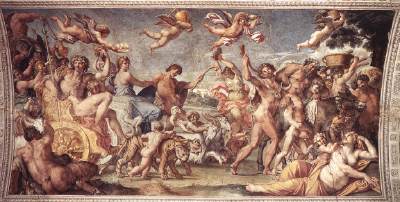
Annibale Carracci, “Triumph of Bacchus and Ariadne.”
1597-1602. Wikipedia. Web. 27 July 2011.
http://en.wikipedia.org/wiki/The_Loves_of_the_Gods_(Carracci)
|
The Farnese
ceiling, where this painting appears, shows an attempt to revitalize
the High Renaissance. Yet “its illusionism, its decorative,
sensuous, and lighthearted use of accessories, and its physical
power, exuberance, and rich compositions of the individual
paintings, anticipate the Baroque” (Gowing 697).
|
|

Caravaggio, “The Calling of Saint Matthew.”1599-1600.
Wikipedia. Web. 27 July 2011.
http://en.wikipedia.org/wiki/The_Calling_of_St_Matthew_(Caravaggio) |
Notice the use
of chiaroscuro—strong contrast
of light and darkness |
|

Caravaggio, “David with the head of Goliath.”1609.
Galleriaborghese. Web. 27 July 2011. http://www.galleriaborghese.it/borghese/en/edavicara.htm
|
Note that
Goliath’s head is actually Caravaggio’s self-portrait. |
|
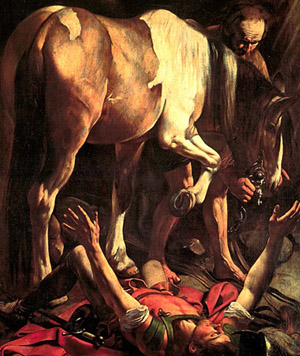
Caravaggio, “The Conversion on the Way to
Damascus”.1600.
Wikipedia. Web. 27 July 2011.
http://en.wikipedia.org/wiki/Conversion_on_the_Way_to_Damascus |
Saul’s body is
foreshortened. |
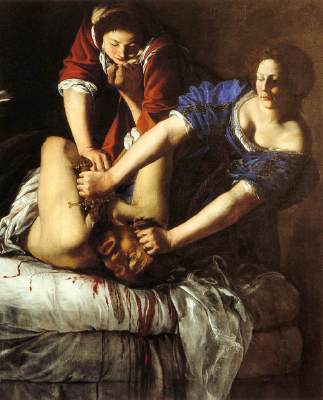
Artemisia Gentileschi,” Judith slaying
Holofernes.” ca. 1620.
Wikipedia. Web. 27 July 2011. http://en.wikipedia.org/wiki/Artemisia_Gentileschi |
Her source might
very well be Caravaggio's Judith ten years earlier. But her work
might also represent a psychological reaction to her unfortunate
experience as a rape victim. |
|
|
Painting:
France
|
|
Nicolas Poussin
(1593/4-1665)
--Baroque classism
--Works characterized by perfect clarity of form and structure
The Classical Baroque
|
Restraint |
Moderation |
Decorum |
Propriety
|
Good taste |
|
|
Painting:
Spain
|
|
Diego Velazquez
(1509-1661)
|
|
--His career was closely linked to the Spanish court.
--“A fascination with the everyday, and a sense that it possesses
its own transcendent value, is a major underlying theme of
Velasquez’s art” (Lucie-Smith 266) |
|
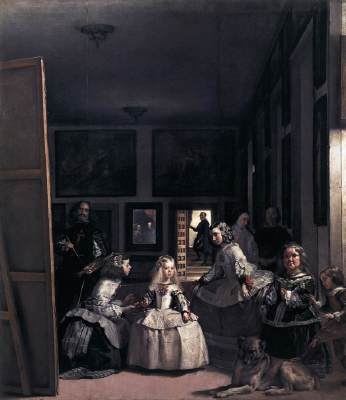
Diego Velasquez, “Las Meninas (The Maids of
Honor).” 1656. Wikipedia.
Web. 27 July 2011.
http://en.wikipedia.org/wiki/Las_Meninas |
“The painting is
based on a visual pun: the spectator takes the place of the king and
queen, whom Velasquez is busy painting (their joint images appear in
the background, dimly reflected in a mirror” (Lucie-Smith 267-68). |
|
|
Painting: Flanders
|
|
Peter
Paul Rubens (1577-1640) |
|
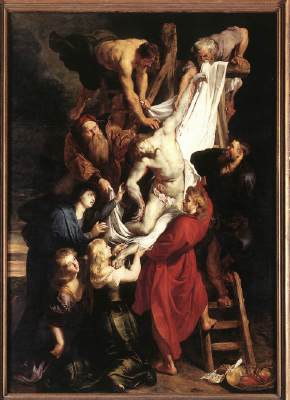
Peter Paul Rubens.
“The Descent
from the Cross.” 1612-14.
Wikipedia. Web. 27 July
2011.
http://en.wikipedia.org/wiki/File:La_descente_de_croix_Rubens.jpg |
--Painted for
Antwerp Cathedral
--The mood is
the most profound sorrow
--Note the
emphasis on diagonals.
|
|
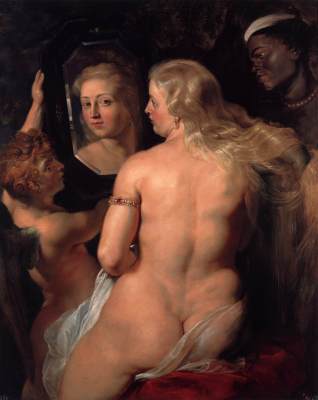
Peter Paul Rubens, “Venus at a Mirror.” c.
1615.
Wikipedia. Web. 27
July 2011. http://en.wikipedia.org/wiki/File:Rubens_Venus_at_a_Mirror_c1615.jpg |
Major theme:
sensuous seduction |
|
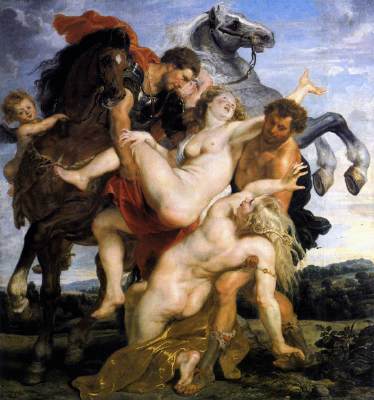
Peter Paul Rubens, “Rape of the Daughters of
Leucippus.” c. 1617.
WIkipedia. Web. 27 July 2011.
http://en.wikipedia.org/wiki/File:07leucip.jpg |
--“The two
daughters of King Leucippus were betrothed to a set of twins,
cousins of Castor and Pollux. But the latter pair carried the
maidens off and had sons by them.”
--The myth is
symbolic of physical passion.
--baroque
feature: radiance and abundance in color.
(1) to
commemorate the double marriage of Louis XIII of France to a Spanish
princess and Philip IV of Spain to a French princess
(2) a message of
(male) power over (female) privilege
(Fiero 73)
|
|
|
Painting: Holland
|
|
Rembrandt Van
Rijn (1606-69)
|
|
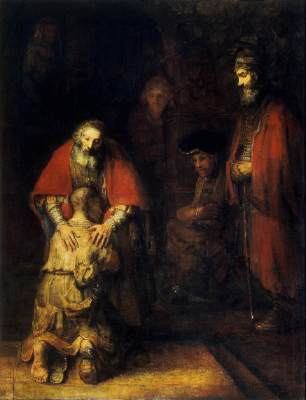
Rembrandt, The Return of the Prodigal Son,
c. 1669. Wikipedia. Web. 27 July 2011.
http://en.wikipedia.org/wiki/The_Return_of_the_Prodigal_Son_(Rembrandt) |
“For theatrical
effect, Rembrandt has pulled the figures out of the shadowy depths
of the background. The father and son, bathed in golden light, form
an off-center triangle balanced by the sharply lit vertical of the
figure on the right” (Fiero 106-7). |
|
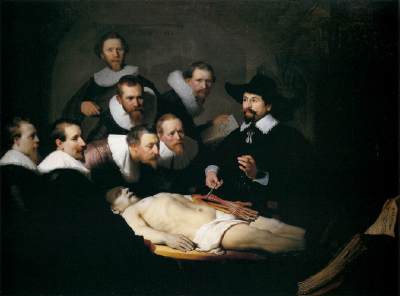
Rembrandt, “The Anatomy Lecture of Dr.
Nicolaes Tulp.”1632.
Wikipedia. Web. 27 July 2011.
http://en.wikipedia.org/wiki/The_Anatomy_Lesson_of_Dr._Nicolaes_Tulp |
“In the company’s fascinated intentness on the corpse there is a
palpable unease, almost an awareness of their own mortality” (Piper
216) |
|
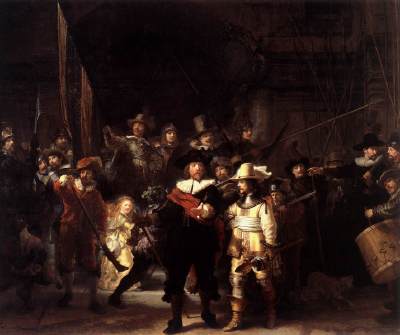
Rembrandt, “The Nightwatch.”1642. WIkipedia. Web. 27
July 2011.
http://en.wikipedia.org/wiki/Night_Watch_(painting) |
--Chiaroscuro
is used as a dramatic device.
--”A company of
Amsterdam musketeers is marching out—actually in daylight—under the
command of their captain” (Lucie-Smith 300).
|
|
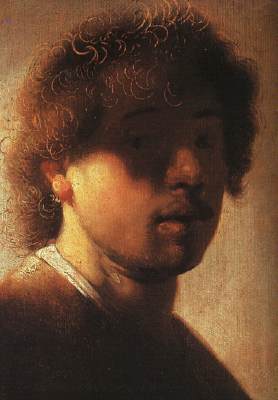
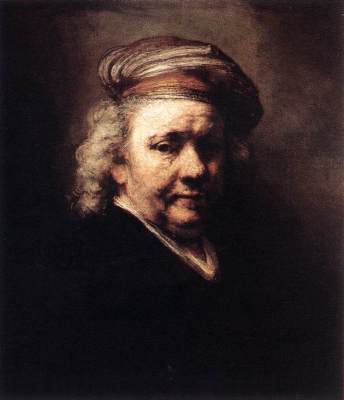
(left)
Rembrandt, “Self-Portrait.”
1627. Rembrandtpainting. Web. 27 July 2011.
<http://www.rembrandtpainting.net/rembrandt_self_portraits.htm>
(right)
Rembrandt, “Self-Portrait.”1669.
Rembrandtpainting.
Web. 27 July 2011.
<http://www.rembrandtpainting.net/rembrandt_self_portraits.htm>
|
Rembrandt’s Self-Portraits |
|
|
Jan Vermeer
(1632-75) |
|
|
|
ii. Sculpture
|
|
--“What is most
typically and fundamentally Mannerist about Cellini’s statue is the
way in which the artist distances himself from what is being shown,
and makes a bloody deed playful and rather elegant. Even the blood
spurting from Medusa’s trunk is treated in a decorative way”
(Lucie-Smith 235-236)
--“a challenge
to the artist’s virtuosity: three figures into a coherent spiral”
(Piper 169)
--The artificial contortions portray the physical stresses.

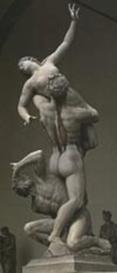

Source:
(left)
Benvenuto Cellini, “Perseus with the Head of Medusa.” 1554.
Wikipedia. Web. 27 July 2011. http://en.wikipedia.org/wiki/File:Firenze_perseo_cellini_1.jpg
(middle)
Giovanni
Bologna, “Rape of a Sabine.” 1583.
Bluffton. Web. 27
July 2011. http://www.bluffton.edu/~sullivanm/lanzi/lanzi2.html
(right)
Giambologna, “Hercules
Beating the Centaur Nessus.”1599.
Artcyclopedia. Web. 27
July 2011.
http://www.artcyclopedia.com/artists/giambologna.html |
|
Gianlorenzo
Bernini
(1598-1680)
|
|
An Italian
baroque architect and sculptor
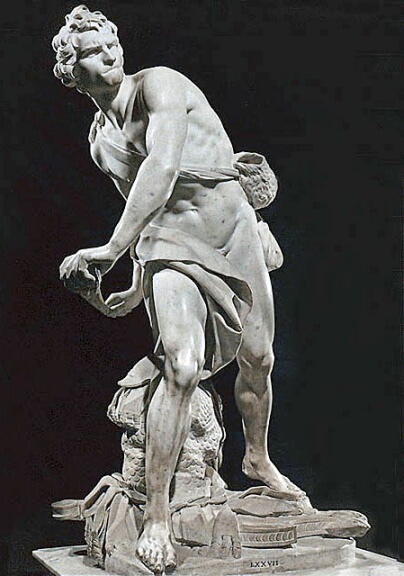
Bernini, “David.”
ca. 1623.
Owensboro. Web. 27 July 2011.
http://legacy.owensboro.kctcs.edu/crunyon/Eng262/01-neoclassicism/01-intro/Enlightart.htm |
|
Renaissance vs. Baroque |
|
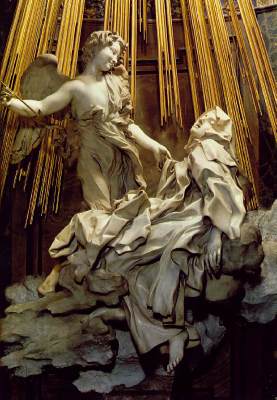
Gianlorenzo Bernini, “The Ecstasy of St. Teresa.”
1645-52. Columbia. Web.
http://www.mcah.columbia.edu/arthum2/publicportfolio.cgi?view=2758&columns=2 |
The work depicts
one of St. Teresa’s visions, in which an angel appeared to her and
pierced her heart with a faming golden arrow: “The pain was so great
that I screamed; but simultaneously I felt such infinite sweetness
that I wished the pain to last eternally.” (Lucie-Smith 257) |
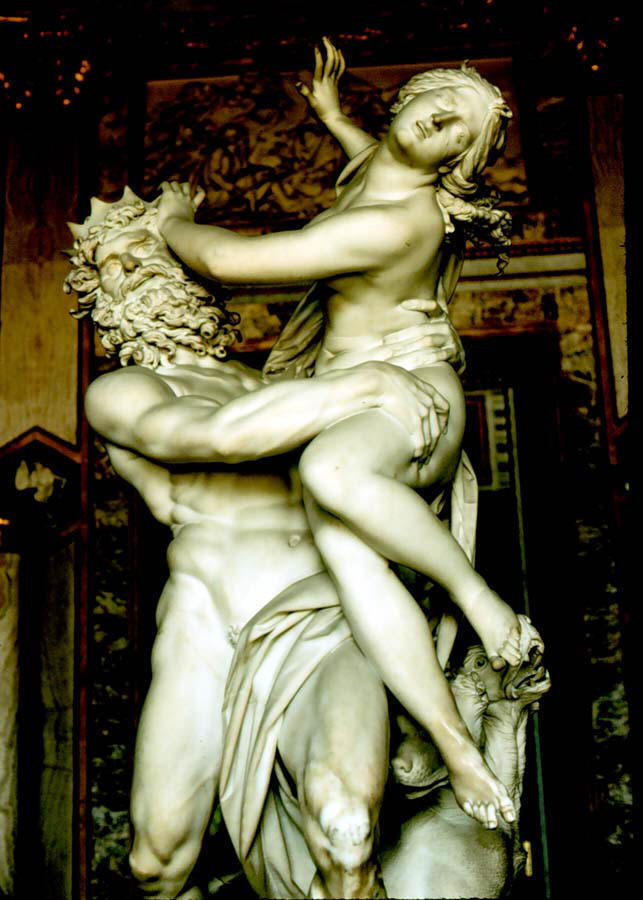
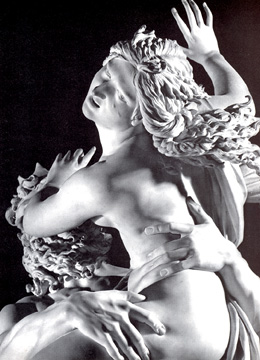
Bernini, “The Rape of Proserpina.”
1621-22. Wikipedia. Web.
27 July 2011.
http://en.wikipedia.org/wiki/index.html?curid=8969400 |
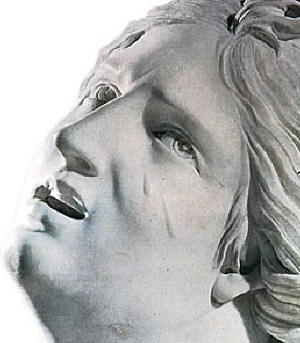
“The two figures burst violently apart from
one another . . . . Bernini is interested in . . .
expressing emotions—brutality and lust on the one hand, fear
on the other—which he wants to bring home to the spectator a
forcefully as possible” (Lucie-Smith 256).
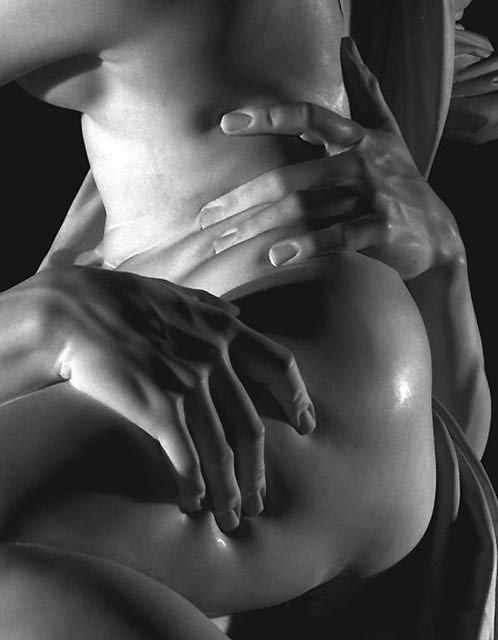
Bernini, “The Rape of Proserpina.” 1621-22. Wikipedia.
Web. 27 July 2011.
http://en.wikipedia.org/wiki/index.html?curid=8969400 |
|
|
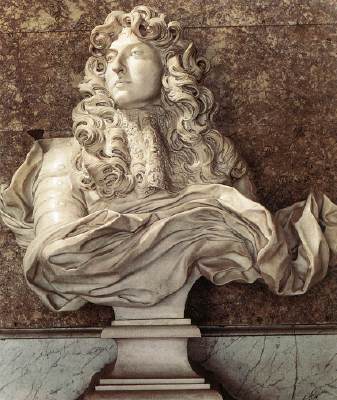
Source:
Bernini, “Bust of Louis XIV.” 1665. Bluffton.
Web. 27 July 2011.
http://www.bluffton.edu/~sullivanm/france/versailles/bernini/louisfourteen.html

|
|
Works Cited
|
|
Cunningham, Lawrence and John Reich. Culture and Values. 4th
ed. Fort Worth: Harcourt Brace, 1998.
Fiero, Gloria. The Humanistic Tradition. Vol. 2. 6th
ed. New York: McGraw-Hill, 2011.
Gowing, Sir Lawrence, ed. A History of Art. Rev. ed.
Oxfordshire, UK: Andromeda, 1995.
Lerner, Robert E., Standish Meacham, and Edward McNall Burns.
Western Civilizations. 13th ed. New York: Norton,
1998.
Lucie-Smith, Edward. Art and Civilization. Englewood Cliffs,
NJ: Prentice Hall, 1992.
Perry, Marvin. Western Civilization: A Brief History. 4th
ed. Boston: Houghton Mifflin, 2001.
Piper, David. The Illustrated History of Art. London:
Chancellor, 1981.

|
|
|
|
|
|
|
|
|
|
|
|
|
|
|
|
|
|
|
|
|
|
|
|
|
|
|
|
|
|
|
|
|
|
|
|
|
|
|
|
|
|
|
|
|
|
|
|
|